The incredible true story of American fighters taking on an Iranian drone swarm and winning
- By Alex Hollings
Share This Article
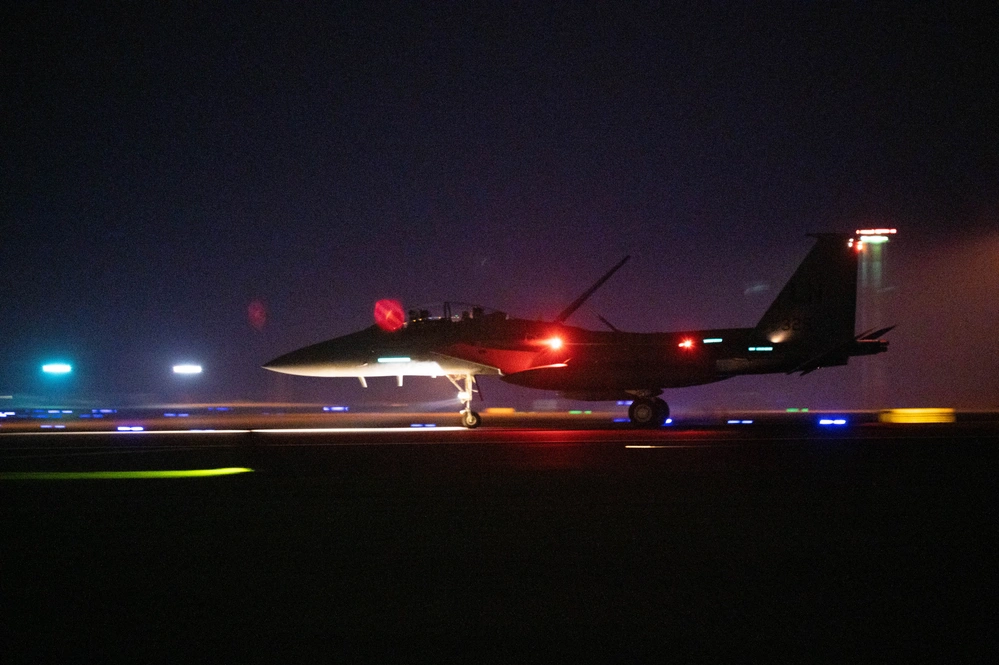
On the night of April 13, 2024, Iranian and proxy forces throughout the Middle East launched “Operation True Promise” a massive aerial attack that would see hundreds of drones and missiles pour into the night sky with their sights set on targets inside Israel. This barrage of munitions saturated the sky from seemingly every angle, with slow-moving loitering munitions traversing the hundreds of miles to their targets at low altitudes, ballistic missiles screaming through the sky at hypersonic speeds tens of thousands of feet above them, and air-breathing cruise missiles soaring in between.
At an undisclosed airbase in the region, American F-15E Strike Eagles scrambled under a symphony of Patriot interceptors striking drones and cruise missiles overhead, raining debris down onto the airfield. Air Force personnel were instructed to seek shelter in nearby bunkers, but many remained on the flightline pumping fuel and loading ordnance onto aircraft to get them into the fight.
Further south, F-16s, deployed out of the Washington DC Air National Guard’s 113th Wing, were the first to engage the flood, and their radio chatter confirmed just how serious the situation was.
“A message comes across that just says … like Viper 72 is ‘Winchester,’ which means they are out of missiles. They have no bullets left. They have nothing,” explained F-15E pilot Maj. Clayton “Rifle” Wicks.
As the targets came into range, the Strike Eagles opened fire, launching missile after missile at targets they could barely see. When their missiles ran dry, some fighters switched to guns, diving below safe operating altitude to chase their targets through the inky darkness.
When the fighting finally subsided, only six weapons out of some 300 launched reportedly struck Israel with the rest being wiped out by fighters and air defenders in what’s being described as the largest air-to-air engagement in half a century. But in the heat of the moment, success was anything but assured. So let’s talk about what happened on the night of April 13.
Related: Two new American missiles that will make a bang
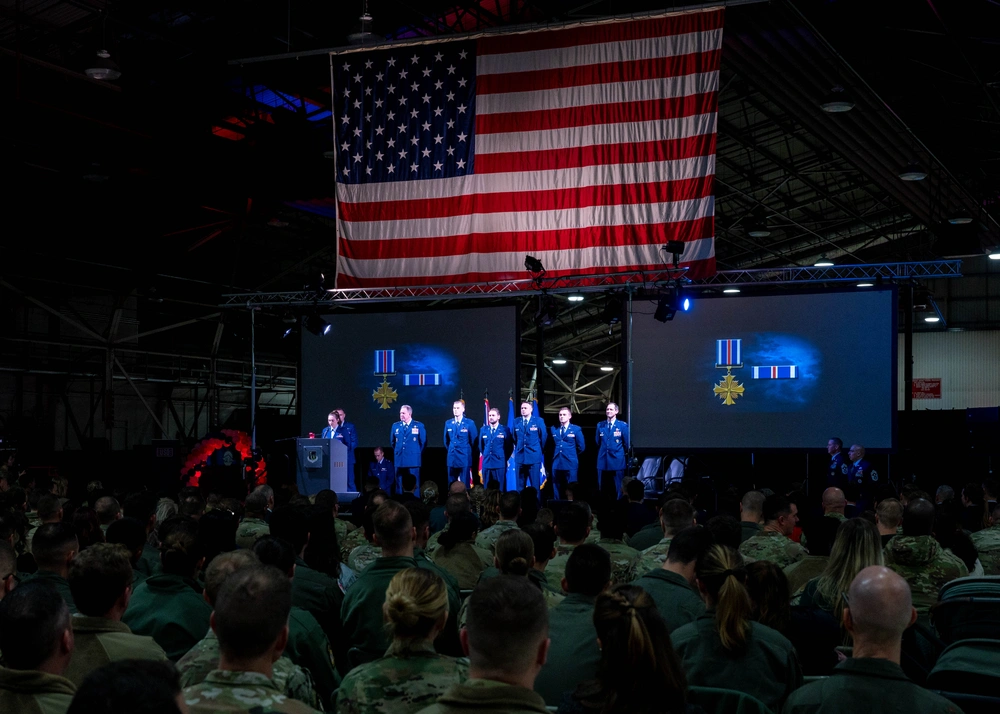
Recently, 30 servicemembers were recognized for their commitment to duty and courage under fire during the Iranian attack of April 13, 2024. Among them were Capt. Lacie “Sonic” Hester, an F-15E Strike Eagle Weapon Systems Officer, and her pilot, Maj. Benjamin “Irish” Coffey, both of whom received the nation’s third highest award for valor, the Silver Star. For Sonic, the award also comes with a historic footnote as she’s the first female Airman ever to earn the distinction, and only the third woman force-wide to be awarded the Silver Star since World War II.
No fewer than 14 other Airmen received Distinguished Flying Crosses, six with V devices to denote valor, and four more to indicate action in combat. Six received Air and Space Commendation medals, and six others received Air and Space Achievement Medals. It was a momentous occasion that reflected the bravery and professionalism demonstrated throughout the engagement and the record-setting performance turning aircraft around and getting them back into the fight.
Just over seven months earlier, at an undisclosed air base in the Middle East, moods were decidedly less celebratory. The men and women of the UK-based 494th Fighter Squadron – known as the Panthers – had been deployed to the region since the preceding October, heading to the Middle East shortly after the October 7th Hamas-led terror attack on Israel kicked off the ongoing and controversial conflict in Gaza. In the intervening months, Panthers had downed several Iranian-made drones making their way toward Israel, but for the most part, things had been fairly quiet.
But as Israel and Iran continued to trade tit-for-tat attacks, Maj. Benjamin “Irish” Coffey recognized that it was only a matter of time before he and his wingmen would be facing a much bigger challenge. Of the three types of weapons Iran would likely use in a large-scale attack on Israel, two were within the Strike Eagle’s means to bring down.
This increasingly inevitable attack, Coffee knew, would come in the form of ballistic missiles, like Iran’s Sejil missile, air-breathing cruise missiles, like their Soumar, and one-way drones like the infamous Shahed-136 that’s seen significant use in Ukraine under the Russian designation, Geran-2.
Ballistic missiles can be thought of as weaponized rockets, carried aloft by conventional rocket propulsion before separating from the booster at extremely high altitudes and careening back toward their targets at immense speeds – sometimes in excess of Mach 20. In fact, despite common perceptions of hypersonic missiles being the fastest in service, ballistic missiles often travel at higher speeds and reach their targets sooner; but none of this would be Coffee’s concern.
Related: The ultimate guide to the Patriot air defense system
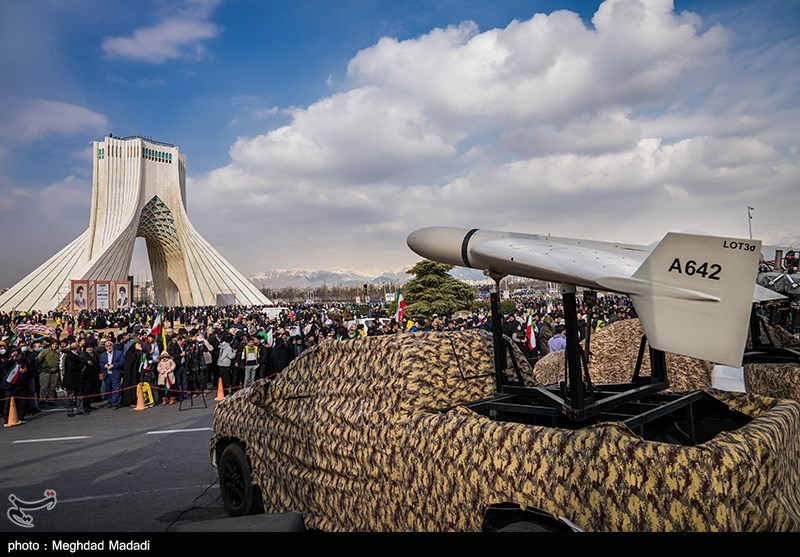
Air defense platforms like America’s MIM-104 Patriot, which has seen success downing Russia’s faux-hypersonic Kinzhal missiles in Ukraine, and Israel’s Arrow 2 and Arrow 3 systems, are particularly well suited for ballistic missile defense and it would be up to them to keep these high-flying threats from making landfall.
Unlike ballistic missiles, cruise missiles are usually powered by air-breathing jet engines – often turbojets similar to those you might find in dated fighters. This allows cruise missiles to fly a lot like fighters do, along fairly horizontal flight paths while using the curvature of the earth and even the terrain to mask their approach. American fighter pilots often train to bring down these threats, but this is another area where air defense systems tend to perform well. Cruise missiles also tend to be quite expensive, meaning Iran was less likely to employ them in really significant numbers.
That left one-way drones and loitering munitions like the aforementioned Shahed-136, and that posed a serious problem. While the F-15E carries the modern and advanced AN/APG-82v1 Active Electronically Scanned Array radar, loitering munitions represent a unique challenge. Not only are drones very small targets, but their low flying altitude makes it easier for them to blend in with the ground clutter. Their small radar cross sections and low speeds are also an issue, as the fighter’s targeting software was designed for engaging larger airborne targets like enemy aircraft and may mistake something flying low, slow, and erratically as nothing more than a bird.
“You’re talking about something that is on the very edge of a fighter aircraft’s ability to detect – what we call ‘find, fix, track, target and engage,'” Coffey told CNN. “The best radar in the inventory is in [the F-15E], and no one really knew whether or not its capability to find these [drones] even existed.”
So, Coffee took the initiative, reviewing footage from the few drone engagements the 494th had already conducted and combining it with every other resource he could find. He then drafted a paper for the unit on the most effective methods of locating, targeting, and engaging drone threats. As the days passed, the paper made its rounds to aircrews throughout the unit, but there was little opportunity to practice the recommended tactics as the Airmen waited on high alert for Iran’s attack.
And then, on April 1, Israel struck targets in Syria that housed senior members of Iran’s elite Islamic Revolutionary Guard Corps. Word of Iran’s pending reprisal spread throughout the region like wildfire. Recognizing that the attack would almost certainly come at night, the squadron soon put plans into place to keep two Strike Eagles in the air at all times throughout the night, flying in six-hour shifts, with additional crews ready to launch more fighters within 30 minutes if and when the attack commenced.
“We were on kind of an alert status for about a week, week and a half, leading up to that point,” said Maj. Clayton “Rifle” Wicks. “We knew that there was going to be some sort of large-scale attack. How big we didn’t quite know, and when exactly we didn’t quite know.”
Related: How the F-16 changed air warfare forever
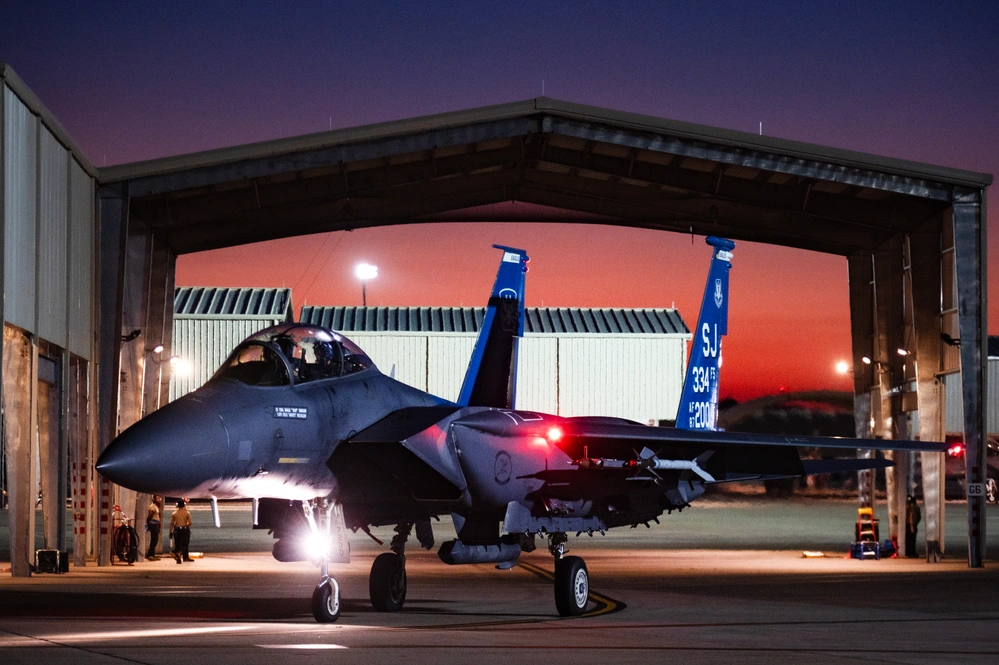
On the night of April 13, Coffey and Hester prepared for their six-hour shift, alongside squadron commander, Lt. Col. Curtis Culver, and Lt. Col. Timothy Causey in the second Strike Eagle. As the air crews later recounted, they walked into their nightly briefing expecting more of the same waiting game they’d grown accustomed to – but that night, things were very different.
Maj. Wicks had flown his shift the night prior, so on April 13, he was serving in the role of “operations supervisor,” relaying information between the Combined Air Operations Center, other command-and-control elements, and the crews in their aircraft. He was the first to receive the intelligence report that Iran was mobilizing its missile forces and the attack was imminent. As he recalled, he relayed all the information he could to the pilots as they headed straight for their waiting aircraft on the flight line. But there were still lots of question marks dominating the airspace above them.
“Things were just happening so fast out there that it was pretty much a sort of a pickup game. I remember feeling guilty that I couldn’t do more for them, before launching my friends out into the darkness to who knows what,” Wicks said. “So that part was tough.”
The Strike Eagles roared into the sky carrying eight air-to-air missiles each, though we don’t know how many of which types of missiles. At least one pilot testimony mentioned firing a “Fox 3,” which denotes an active radar-guided missile. This could only be a variant of America’s AIM-120 Advanced Medium Range Air-to-Air Missile (AMRAAM), but it’s likely these jets carried a mix of AMRAAMs are shorter-ranged infrared-guided AIM-9 Sidewinders.
Wicks monitored the command and control feed as his wingmen were joined by newly arrived F-15Es from the 335th Fighter Squadron out of Seymour Johnson Air Force Base in North Carolina. Farther south, F-16s out of the DC National Guard’s 113th Wing were also flying. They were the first to engage the incoming drones and missiles. Within minutes, Wicks received an update on the nature of the threat headed their way.
“A message comes across that just says … like Viper 72 is ‘Winchester,’ which means they are out of missiles. They have no bullets left. They have nothing,” Wicks said. “And I remember, I got chills, and the hair on the back of my neck stood up, because that was the first time I was like, ‘Oh my gosh. Command and control can’t keep up with the amount of missiles that are being shot and things that are happening.’ And that’s the only message they got across.”
As the base sprang into action over the closing attack, Airman 1st Class Isaac Schumann, an F-15 engine mechanic on the ground, recalled the exact moment the fight arrived over their remote air base.
“One of the weapons guys kinda pointed off into the distance, and so we all turned and looked, and you could see the Patriot systems – all the stuff that’s supposed to be defending our base – going off and blowing up the drones and stuff in the sky.”
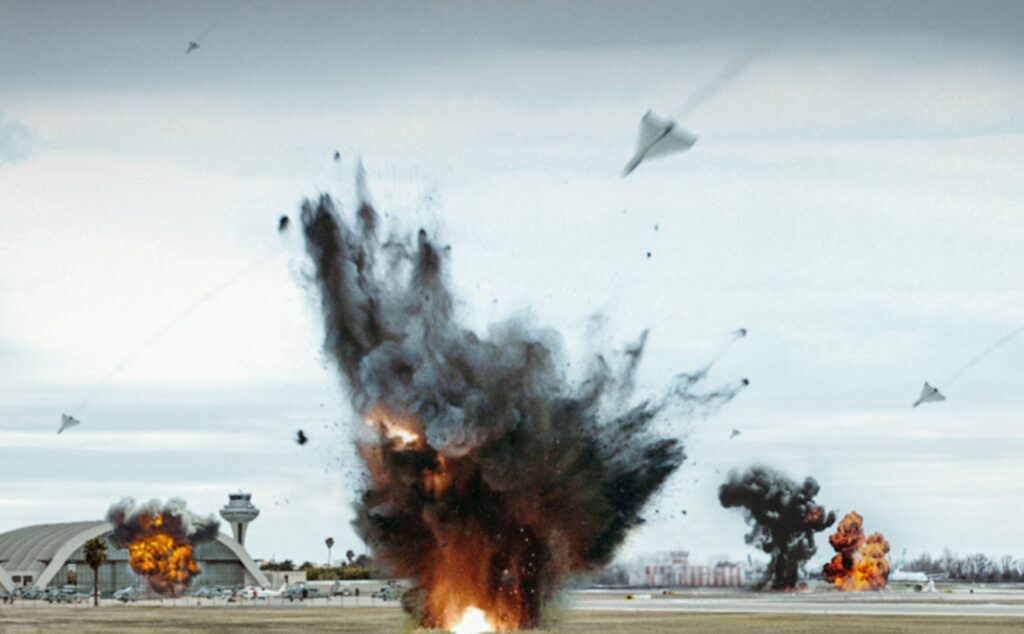
In the air a few thousand feet above them, Coffey and Hester were playing the role of mission commanders, coordinating with other aircraft to divide the airspace up into lanes and ensure they were all covered. Just as Coffey had predicted, they were staring straight into the face of an approaching drone swarm… and these drones were anything but 20-pound quadcopters.
Iran’s Shahed-136 is among a new class of weapon that blurs the line between cruise missile and drone. Often referred to as a loitering munition or kamikaze drone, these platforms stretch about 11 feet from front to back (3.5 meters) with an 8.2-foot wingspan (2.5 meters). At roughly 440 pounds, they can carry a 110-pound high-explosive warhead to targets as far as 1,600 miles away at speeds of around 115 miles per hour. As the aircrews watched from their cockpits, their radar appeared to be filling up with the them.
Yet, recognizing the difficulty their radar might have in identifying low-and-slow flying drones, Hester switched over to the Strike Eagle’s targeting pod to confirm their targets. As Hester relayed her visual confirmation, Coffey came to realize just how serious the situation was becoming.
“I first get hit with dread, recognizing the numbers we were seeing,” Coffey recalled, “This wasn’t a small-scale or a chest-thumping show of force. This was an attack designed to cause significant damage, to kill, to destroy, and now we are on literally the leading edge of firepower, able to try to do something about that. And that lasted maybe for 10, 15 seconds, and then training kicked in, and it was time to get the job done.”
Captain Austin “Apex” Leake was flying alongside his wingman as the drones breached the horizon. He recalls Coffey calling out over the radio, “drone air, Fox 3” indicating that he’d fired his first AMRAAM at an approaching drone.
With that, the fight was on: Coffey and Hester prioritized the attack drones, knowing the multiple layers of air defense systems behind them would have the best chance at knocking down the much smaller number of cruise missiles in the air. The aircrews set about coordinating their targets with one another and engaging them with air-to-air missiles, making multiple passes to bring the drones down.
“As we’re turning away just so we can build some more space from the next wave, you look back and you see drones impacting the ground, like, ‘Oh, they got another one. They got another one,'” added Capt. Matthew “Pepper” Eddins. “Looking a few miles away, and you see another one impacts: ‘Oh, the Vipers got another one.’ And then you hear from your flight lead, Hey, turn hot, so pitch your aircraft back around and target again. ‘Here we go again,’ and it’s just almost repetitive at that point.”
Related: Army’s future helicopters could be more autonomous and launch their own drones
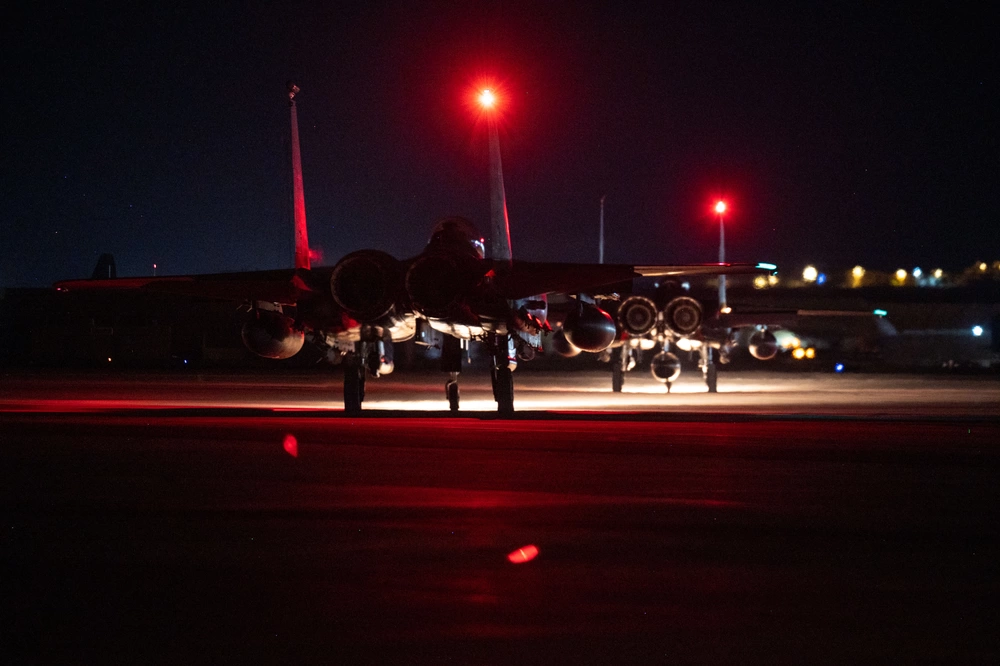
In less than 20 minutes, nearly every weapon on every fighter had been expended, with the notable exception of one missile on Coffey and Hester’s aircraft that had failed to fire, creating yet another potential emergency to contend with, commonly known in aviation circles as “hung ordnance.” It would only get worse from there.
“This missile – we don’t know if it’s armed, and we don’t know if it’s going to explode on our wing,” Coffey said. “We don’t know if it’s going to explode while maintenance is safing the aircraft. It’s a big deal. And now, as we start into the landing process, we enter alarm red.”
Alarm Red effectively means the base was locking down in preparation for an impending attack.
“Missiles and drones are flying over base, and they’re being intercepted over base, so the alarm red goes off,” Causey said. “Then at that point is really when you see a lot of military discipline and a lot of bravery under fire.”
Coffey now needed to not only land his aircraft with a malfunctioning live missile underwing, he had to do it while flying through the hail storm of intercepts taking place around the base. Other Strike Eagles radioed in about explosions in the airspace above the base and were instructed to just stay airborne as long as they could and not to divert to backup airbases as they were likely facing a similar situation.
As part of the Alarm Red protocol, Airmen were instructed to seek shelter in bunkers meant to protect them from the falling debris, but many opted to ignore the order.
“There was an airman at one point standing next to a fuel truck with tons and tons of fuel in it, just pumping gas into the jet, with stuff exploding over the base,” Culver recalled. “I mean the courage of that airman, that American, to stand up and do that for an ally, is incredible.”
Coffey and Hester managed to make it to the ground and they quickly climbed out of their cockpit. The pair had downed six targets with seven missiles before being forced to land, and now, with weapon crews working to safely remove their malfunctioning missile, they could do nothing but run to a bunker themselves. Yet, just a few minutes after arriving in the bunker’s safety, the duo learned that a replacement Strike Eagle was ready to fly – so they dusted themselves off and got back into the fight.
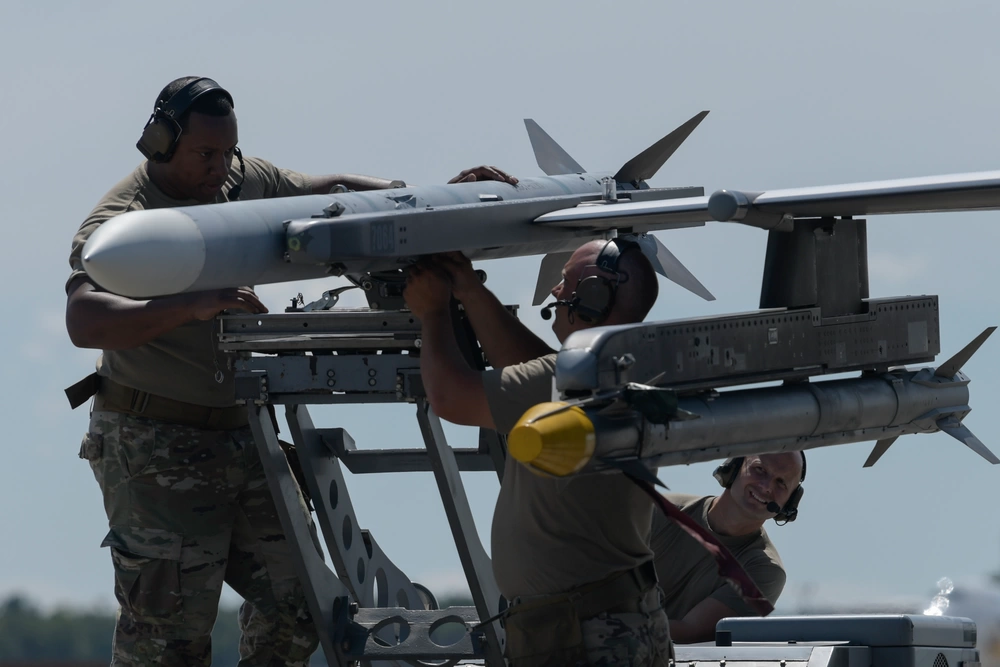
Once airborne, Coffey and Hester got right back into the thick of it, quickly burning through all eight of their air-to-air missiles and eventually, deciding to go in for guns – this is among the most dangerous things a fast-moving fighter like the Strike Eagle could do against explosive targets like drones. The F-15E would struggle to fly slow enough not to zoom past the drones, and if they did score a hit with their M61 Vulcan 20mm autocannon, there was a solid chance their jet would absorb the fireball – and the shrapnel – as it closed the remaining distance.
And to make matters worse, they’d have to fly at extremely low altitude to pull it off, eliminating any margin for error and dramatically increasing the chances of colliding with the ground if Coffey’s concentration faltered for even an instant.
Fortunately then, perhaps, for Coffee and Hester, their first attempt at gun-running the drones failed.
“You feel the terrain rush, you feel yourself getting closer and closer to the ground,” Coffey said, “The risk was just too high to try again.”
While Coffey and Hester weren’t successful at downing a drone with their 20mm cannons, the fact that they’d turn to the cannon at all says a great deal about the severity of the situation these aviators were facing: With hundreds of targets careening through the sky and only so many missiles to bring them down, they were getting desperate.
Back on the ground, mechanics and weapons loaders were braving the hail of falling debris to rapidly re-arm and refuel the fighters to get them back into the fight as quickly as possible. In order to do so, they turned to a procedure commonly called ICTs, or Integrated Combat Turns.
ICTs, or rapidly re-arming and refueling aircraft to turn them around and get them straight back into the fight, had fallen out of favor to some extent in the U.S. Air Force during the relative peace of post-Cold War operations, but the practice has seen a significant resurgence in recent years. Despite the chaos surrounding them, Airman 1st Class Schumann and the rest of the ground crews from the 494th managed to complete an ICT in record time, getting one of the Strike Eagles refueled, re-armed, and back in the air in just 32 minutes.
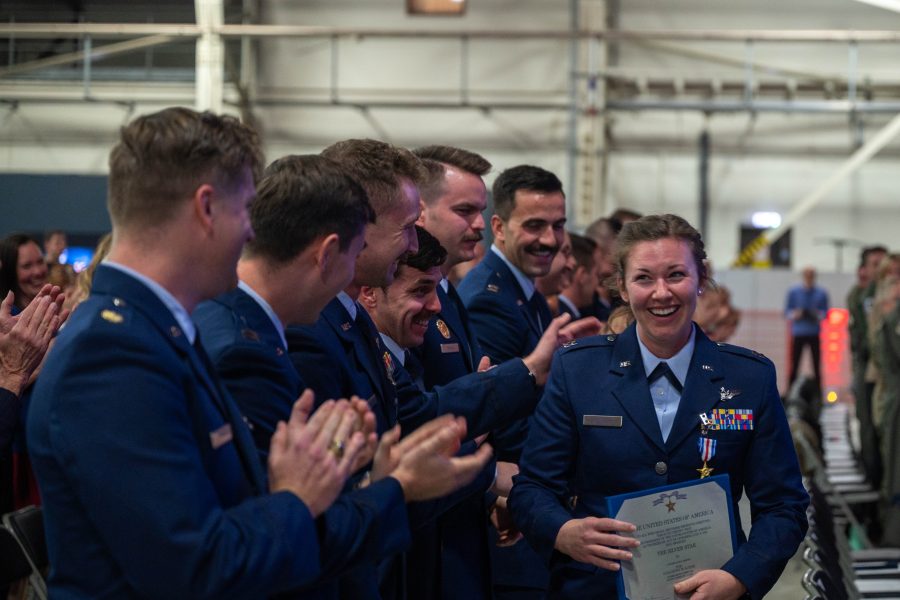
All told, the 66 Airmen of the 494th launched six alert aircraft and a total of 14 sorties while air defense assets engaged missiles and drones flew overhead.
The Strike Eagles of the 494th were responsible for a large portion of the 70 loitering munitions left smoldering in the desert. The coalition of American, British, French, Jordanian, and Israeli forces brought down an incredible 99% of all inbound weapons, with only six of some 300 in total making landfall inside Israel.
Master Sgt. Timothy Adams was among the troops awarded for his actions that night, receiving a Bronze Star for his heroism, but he’s most proud of how the Airmen in the unit handled themselves that night.
“It still gives me chills when I think about how well the team worked together,” said Adams. “I wasn’t the linchpin of that. I was just the guy holding the radio, the node between ops and maintenance. The team is who made it happen. The APG [aircraft maintenance] driver, the weapons teams, the POL [fuels], all those people working together, not running, not dropping the hoses, not just freaking out and worried about their own lives. How could you not be proud of that?”
Feature Image: A U.S. Air Force F-15E Strike Eagle aircraft arrives at RAF Lakenheath, England Jan. 15, 2025. The F-15E Strike Eagles aircraft are equipped with the Eagle Passive/Active Warning and Survivability System marking the delivery of the first F-15E’s integrated with one of the world’s most advanced electronic warfare suites in the European theater. (U.S. Air Force photo by Airman 1st Class Alexander Vasquez)
Read more from Sandboxx News
- Canada’s superior C7 and C8 – Service rifles from around the world
- Unusual and unconventional artillery shells
- Air Force has revealed world’s first two AI-piloted fighter drones
- New details emerge on the F-47, America’s 6th-generation stealth fighter
- America’s power grid could be vulnerable to Chinese hijacking, report finds
Related Posts
Sandboxx News Merch
-

‘Kinetic Diplomacy’ Bumper Sticker (White)
$8.00 Add to cart -

‘Sandboxx News’ Camo Trucker Hat
$29.00 Select options This product has multiple variants. The options may be chosen on the product page -

A-10 ‘Thunderbolt Power’ Poster
$22.00 – $28.00 Select options This product has multiple variants. The options may be chosen on the product page

Alex Hollings
Alex Hollings is a writer, dad, and Marine veteran.
Related to: Military History
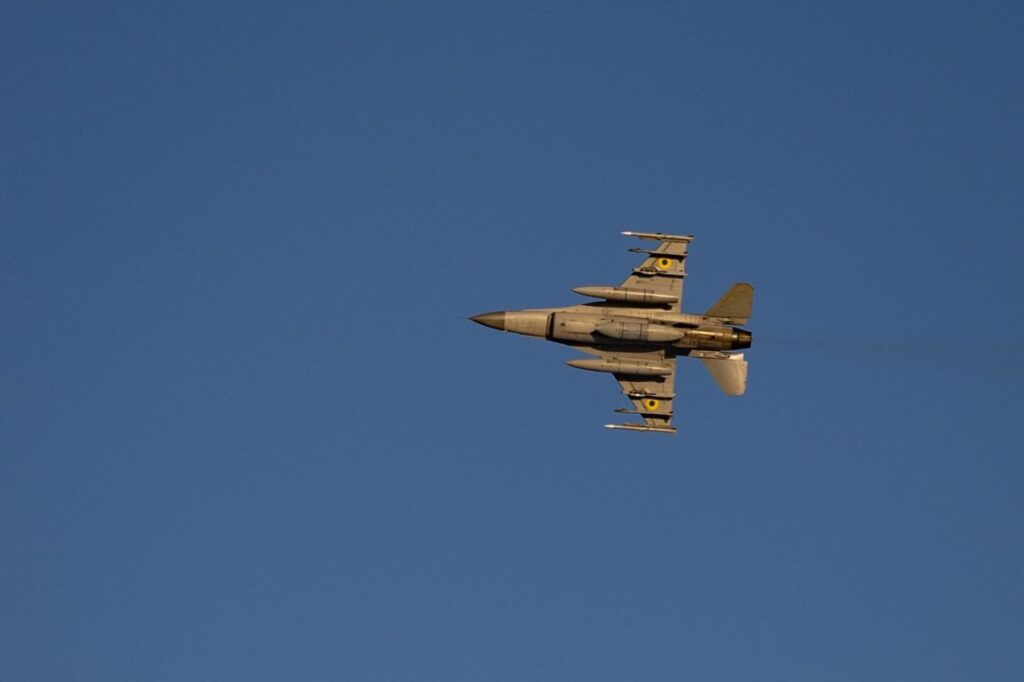
F-16s in Ukraine are putting in the work, according to Ukrainian pilot
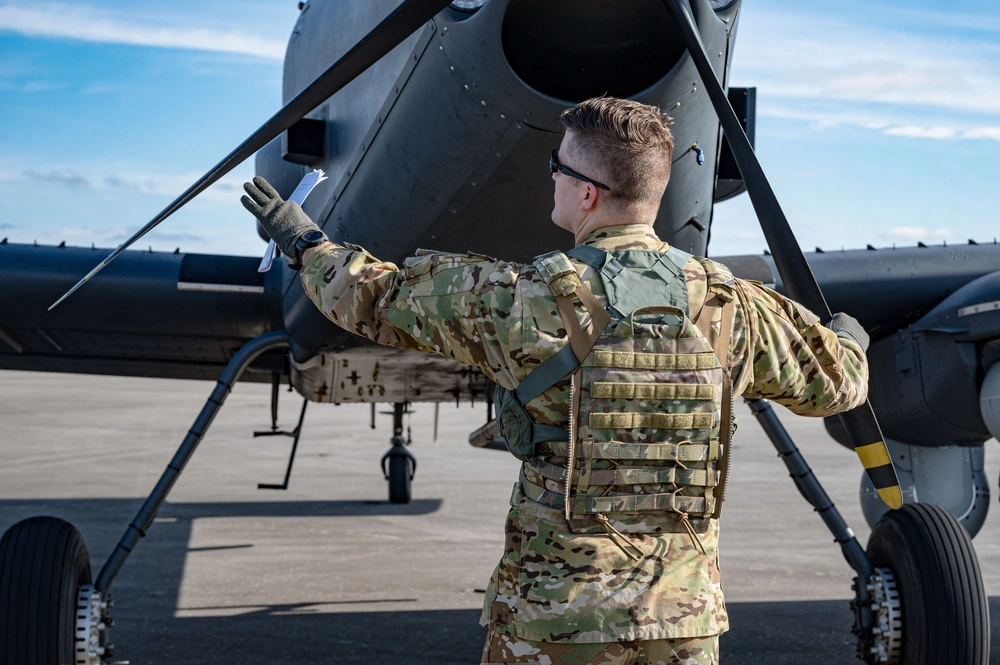
SOCOM’s new OA-1K Skyraider II aircraft will make America’s elite units operating far from home more lethal
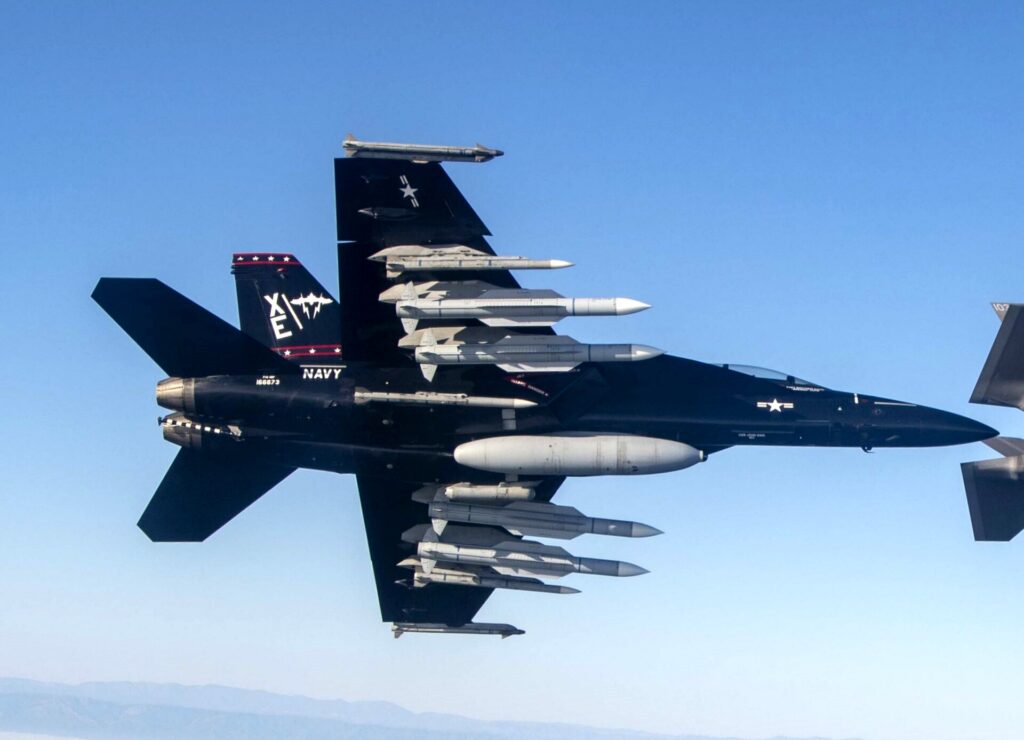
Two new American missiles that will make a bang
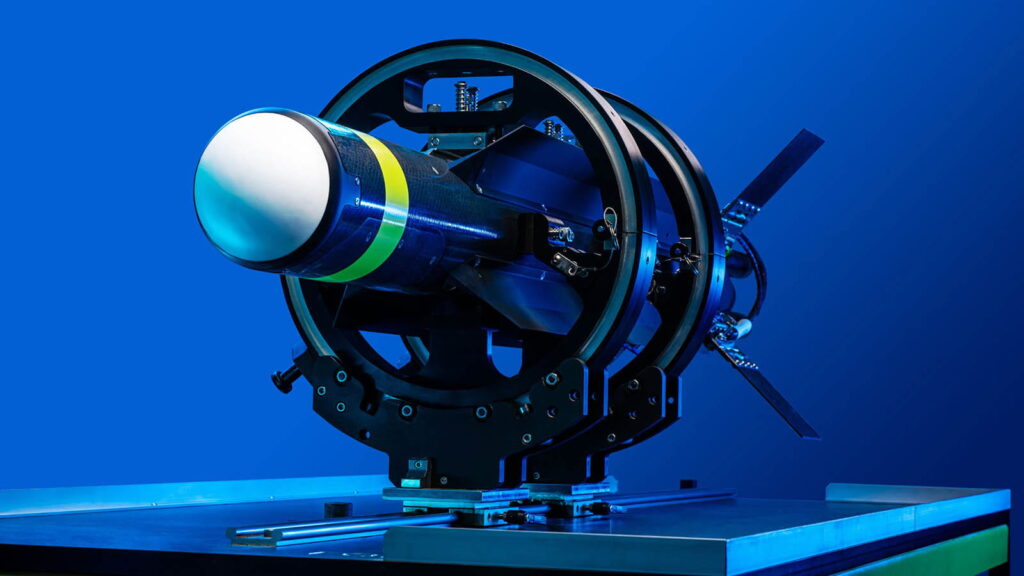
Navy bolsters its aircraft carriers’ defenses with expendable loitering interceptors
Sandboxx News
-

‘Sandboxx News’ Trucker Cap
$27.00 Select options This product has multiple variants. The options may be chosen on the product page -

‘AirPower’ Classic Hoodie
$46.00 – $48.00 Select options This product has multiple variants. The options may be chosen on the product page -

‘AirPower’ Golf Rope Hat
$31.00 Select options This product has multiple variants. The options may be chosen on the product page -

‘Sandboxx News’ Dad Hat
$27.00 Select options This product has multiple variants. The options may be chosen on the product page
